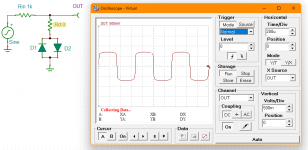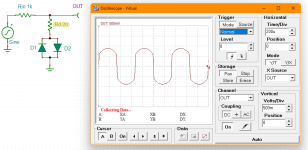I've been reading up on diode softness and curve tracing and all that kind of stuff. 2 threads in particular have made me question some of our understanding of practicalities of measuring the softness of the clipping/conduction knee.
Take this thread for instance on MOSFET clipping, in this case the more interesting Gate to Drain type, not the Gate to Source type where it's essentially just a regular diode.
On the graph the MOSFET looks like it would clip softly, except actually the only holds true at high current, which we might not often actually ever encounter in a pedal. At pedal currents, the clipping is actually quite steep. https://www.freestompboxes.org/viewtopic.php?t=32532
Another thread I've been reading suggests that if you normalise the curves, many that appear to be different actually aren't. Someone also stated, that contrary to what I thought was popular wisdom, putting two of the same diodes in series does soften the curve (as well as increasing vf), it actually stays the same. https://www.diystompboxes.com/smfforum/index.php?topic=121964.0
Would love any theory people to weigh in on their thoughts on all of this.
Take this thread for instance on MOSFET clipping, in this case the more interesting Gate to Drain type, not the Gate to Source type where it's essentially just a regular diode.
On the graph the MOSFET looks like it would clip softly, except actually the only holds true at high current, which we might not often actually ever encounter in a pedal. At pedal currents, the clipping is actually quite steep. https://www.freestompboxes.org/viewtopic.php?t=32532
Another thread I've been reading suggests that if you normalise the curves, many that appear to be different actually aren't. Someone also stated, that contrary to what I thought was popular wisdom, putting two of the same diodes in series does soften the curve (as well as increasing vf), it actually stays the same. https://www.diystompboxes.com/smfforum/index.php?topic=121964.0
Would love any theory people to weigh in on their thoughts on all of this.




